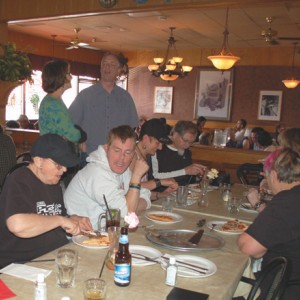Talking About Telephones
One of the realities of aging is that you remember when things were different. I know when TV started because ours was the first on the block. I remember a time before dishwashers, blenders, space travel, and Post-it notes. And I definitely don’t know how to text with my thumbs. This article is a reflection on change.
Thinking about technological change started over pizza at Tony’s. One of the folks we were with mimicked dialing a telephone to emphasize that he had contacted somebody. Because the group was very mixed in age, there were a few present who did not understand what the finger waving in circles in the air meant. The group then began a conversation about our different understandings of telephones depending on our ages. Telephones are only one aspect of changed technology in our lives. Computers of course, are another.
The first telephone we had in our house in the late 1940s was on the wall and you had to turn the crank to ring the operator to put through the call, like Lily Tomlin’s “one-ringy-dingy” on Laugh-In. At that time, telephone calls were expensive and so you didn’t spend a lot of time in conversation. You could think of these short conversations as equivalent to tweeting with only 140 characters. We joked that if you took a breath while talking to my grandmother, she would hang up on you.
Of course, the other reason not to say much was that those early phones were all party lines with two to six households on the same line. Each household would have a distinct ring but everyone on the line would know who was getting a call and could and did listen in. The operator, who physically put through the call, could also listen in, so nothing in this medium at that time was private.
Telephone lines in Alberta were installed by local communities and over time those communities connected to each other, a bit like the beginnings of the Internet. Privacy is also an issue on the Internet, though in a different way.
That was in the 1940s, and until the 1980s and 1990s that was the communication technology. The phones got better and they eventually didn’t need to be on the wall, just attached to it by a cord. There were no cell phones and there were no computers. Cell phones or mobile phones that weren’t attached to the wall began to appear in the 1980s and they were big, really big, not at all like the current sleek devices.
Of course, the other reason not to say much was that those early phones were all party lines with two to six households on the same line. Each household would have a distinct ring but everyone on the line would know who was getting a call and could and did listen in. The operator, who physically put through the call, could also listen in, so nothing in this medium at that time was private.
I was listening to the director of the first Tron movie the other day and he noted that at the beginning of the 1980s, when that movie was made, there were no personal computers. But computers did exist. I started using them for work in the mid-1970s. I remember converting data for “key punching” for the main frame computers. Someone gave me my first personal computer in 1986 in London, England where I was studying. They were leaving England and so they didn’t need it anymore. When I arrived back in Canada, I bought an identical Commodore 64 so I could continue writing my thesis.
The next major jump in technology for me came when we moved into the new Boyle McCauley Health Centre building. In that move we acquired phones with more than one line, a fax machine, and a personal computer on my desk. This was 1990. The fax machine was not quite the same as electronic mail, but it was unquestionably magic – you could send information, a letter, and even a picture instantly. This capacity changed the way we worked.
It changed the way we worked because you could get instant information and in turn it was expected you would provide an instant answer. Prior to the fax machine and email, you might have a conversation with someone about something, and then they would send you a letter which would take three days to come. During that time, you could think about the issue. They in turn wouldn’t expect an answer because you would have to write them back which meant another letter which would take another three days. So, all in all, you had a week to really problem solve and you could phone them in between to discuss the details. Now if you haven’t answered in an hour you get an electronic prompt for a response.
And of course, you don’t dial phones anymore, you punch, thumb type, and instant message in a virtual conversation. Technology has burst with changes in both personal computers and telephones. My mother has never used a cell phone or computer; my sister and I struggle to learn texting; and my children don’t use a telephone book because they use Google on the internet.
From a ringing motion, to dialling, to punching in numbers, to thumb typing so fast the thumbs are a blur, to voice-activated devices, these small actions define your generation.
Sherry lives in McCauley and is a block carrier for the paper.







